|
Editor's Note:
Beatrix Potter was born to a wealthy family in London, England in 1866. Supposedly tutored (but largely ignored) by her governess, she had many long hours to spend alone with a growing menagerie of pets, which she taught herself to draw in startlingly accurate detail and proportion. Her innate intelligence and ability to observe and document minute details of nature should have given her a scientific career. But Victorian England didn't even think women should have "their own" money or property, much less a career in a "man's world."
In 1890, she began illustrating greeting cards, using her pet rabbits as models more often than not. In 1893, still unmarried despite her parent's wishes, she began writing and illustrating her own children's books. It took until 1902 before the first - Peter Rabbit - was published, though. Eventually her writings earned her enough money to buy a farm in the Lake District, where she continued to draw and write until her eyesight failed her.
To protect the beauty of her new home, she used her excess income to keep neighboring farmland out of the hands of developers, eventually donating more than 4,000 acres of farmland to a national trust. (Incidentally, that donation provided not only ongoing beauty, but also critically-needed food for Britain's people during and after World War II - so much other farmland had been sold to housing developers that every acre was needed.)
In the United States, most of Potter's books and illustrations went out of copyright in the 1980s, leading to a flood of cheaply printed books and other materials. The "good" result was that many more children learned about Peter Rabbit and his friends, as well as Bea Potter's unique drawings. The "bad" side was that the illustrations in most of those books were copies of copies of the original printed versions, and even those didn't do justice to Potter's huge drawing talent.
The Tailor of Gloucester is unique in that it was published in two different formats during Potter's lifetime. Bea Potter self-published it in 1902 because she knew that her otherwise trusted publisher (Warne) would demand more drawings and fewer silly mouse songs. In 1903, her publisher did produce a version with more pictures and fewer mouse songs. Ironically, people who grew up with either version tend to resent the the other version when they come across it, just like some folks prefer today's "director's cut" DVD releases over the theatrical release. In all cases, a silly thing to lose sleep over.
Incidentally, this is Beatrix Potter's take on an event that had actually happened Gloucester - a tailor with a potentially career-making commision went home ill - then discovered that his assistants had completed all but one buttonhole in his absence and left it for him to find, without taking the credit. As the story worked its way around Gloucester, credit often went to surreptitious elves, but Beatrix Potter decided to credit another species altogether, one she already loved to draw in all sorts of circumstances. Potter also drew several charming renditions of the Gloucester city streets, which show up nicely in the recovered art we use on this page.
About the Pictures - Nowadays, twenty-one of Potter's paintings for the 1903 edition of this book are on display at Britain's TATE museum. One painting that was used for the 1902 printing is also on display. Because these are so much more detailed and expressive than the printed versions (especially the post-1980 printed versions), we have used photos of the source artwork whenever possible. Sadly, seven of the paintings from the 1903 printing have been lost. For those pictures, we have used high-resolution scans of an early printing. We have additional materials on order, so if we can improve on these scans, we will. In the meantime, clicking on most of the pictures will give you access to bigger versions that I expect you to find delightful.
About Copyrights - By the way, we are free to publish this book in this format in the United States because the copyright has expired and it is in public domain. However, the book may still be under copyright in other countries. If you live outside of the United States, please check the copyright laws of your country before downloading or redistributing the text or graphics of this book.
Please enjoy this charming Christmas tale, told and illustrated by Britain's foremost children's book author and illustrator.
- Paul Race
THE TAILOR OF
GLOUCESTER
BY
BEATRIX POTTER
Author of
"The Tale of Peter Rabbit," etc
"I'LL BE AT CHARGES FOR A LOOKING-GLASS,
AND ENTERTAIN A SCORE OR TWO OF TAILORS" - Richard III
NEW YORK
FREDERICK WARNE & CO, INC
COPYRIGHT, 1903
BY
FREDERICK WARNE & Co.
COPYRIGHT RENEWED, 1931
|
MY DEAR FREDA,
Because you are fond of fairy-tales, and have been ill, I have
made you a story all for yourself - a new one that nobody has
read before.
And the queerest thing about it is - that I heard it in
Gloucestershire, and that it is true - at least about the tailor,
the waistcoat, and the
"No more twist!"
Christmas, 1901
|
 |
THE TAILOR OF GLOUCESTER
|
In the time of swords and periwigs and full-skirted coats with flowered
lappets - when gentlemen wore ruffles, and gold-laced waistcoats of
paduasoy and taffeta - there lived a tailor in Gloucester.
He sat in the window of a little shop in Westgate Street, cross-legged on
a table, from morning till dark.
|
 |

|
All day long while the light lasted he sewed and snippeted, piecing out
his satin and pompadour, and lutestring; stuffs had strange names, and
were very expensive in the days of the Tailor of Gloucester.
But although he sewed fine silk for his neighbours, he himself was very,
very poor - a little old man in spectacles, with a pinched face, old
crooked fingers, and a suit of thread-bare clothes.
|
|
He cut his coats without waste, according to his embroidered cloth; they
were very small ends and snippets that lay about upon the table - "Too
narrow breadths for nought - except waistcoats for mice," said the tailor.
|
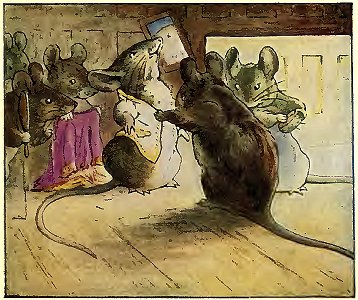
|

|
One bitter cold day near Christmastime the tailor began to make a coat - a
coat of cherry-coloured corded silk embroidered with pansies and roses,
and a cream coloured satin waistcoat - trimmed with gauze and green
worsted chenille - for the Mayor of Gloucester.
|
|
The tailor worked and worked, and he talked to himself. He measured the
silk, and turned it round and round, and trimmed it into shape with his
shears; the table was all littered with cherry-coloured snippets.
"No breadth at all, and cut on the cross; it is no breadth at all; tippets
for mice and ribbons for mobs! for mice!" said the Tailor of Gloucester.
When the snow-flakes came down against the small leaded window-panes and
shut out the light, the tailor had done his day's work; all the silk and
satin lay cut out upon the table.
There were twelve pieces for the coat and four pieces for the waistcoat;
and there were pocket flaps and cuffs, and buttons all in order. For the
lining of the coat there was fine yellow taffeta; and for the button-holes
of the waistcoat, there was cherry-coloured twist. And everything was
ready to sew together in the morning, all measured and sufficient - except
that there was wanting just one single skein of cherry-coloured twisted
silk.
| |

|
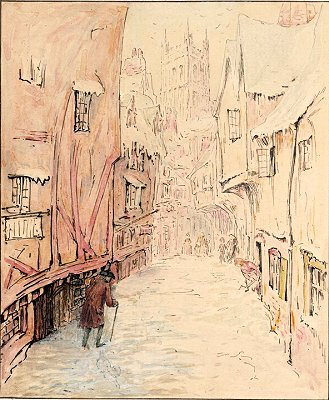
| The tailor came out of his shop at dark, for he did not sleep there at
nights; he fastened the window and locked the door, and took away the key.
No one lived there at night but little brown mice, and they run in and out
without any keys!
For behind the wooden wainscots of all the old houses in Gloucester, there
are little mouse staircases and secret trap-doors; and the mice run from
house to house through those long narrow passages; they can run all over
the town without going into the streets.
But the tailor came out of his shop, and shuffled home through the snow.
He lived quite near by in College Court, next the doorway to College
Green; and although it was not a big house, the tailor was so poor he only
rented the kitchen.
|
|
He lived alone with his cat; it was called Simpkin.
Now all day long while the tailor was out at work, Simpkin kept house by
himself; and he also was fond of the mice, though he gave them no satin
for coats!
"Miaw?" said the cat when the tailor opened the door. "Miaw?"
The tailor replied - "Simpkin, we shall make our fortune, but I am worn to
a ravelling. Take this groat (which is our last fourpence) and Simpkin,
take a china pipkin; buy a penn'orth of bread, a penn'orth of milk and a
penn'orth of sausages. And oh, Simpkin, with the last penny of our
fourpence buy me one penn'orth of cherry-coloured silk. But do not lose
the last penny of the fourpence, Simpkin, or I am undone and worn to a
thread-paper, for I have NO MORE TWIST."
|

|
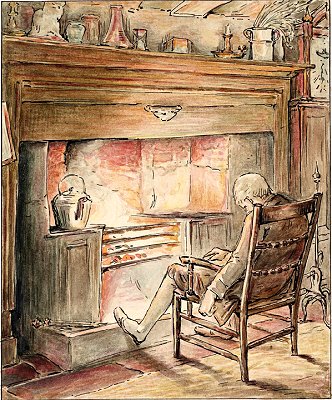
|
Then Simpkin again said, "Miaw?" and took the groat and the pipkin, and
went out into the dark.
The tailor was very tired and beginning to be ill. He sat down by the
hearth and talked to himself about that wonderful coat.
"I shall make my fortune - to be cut bias - the Mayor of Gloucester is to be
married on Christmas Day in the morning, and he hath ordered a coat and an
embroidered waistcoat - to be lined with yellow taffeta - and the taffeta
sufficeth; there is no more left over in snippets than will serve to make
tippets for mice - - "
Then the tailor started; for suddenly, interrupting him, from the dresser
at the other side of the kitchen came a number of little noises -
Tip tap, tip tap, tip tap tip!
|
|
"Now what can that be?" said the Tailor of Gloucester, jumping up from his
chair. The dresser was covered with crockery and pipkins, willow pattern
plates, and tea-cups and mugs.
The tailor crossed the kitchen, and stood quite still beside the dresser,
listening, and peering through his spectacles. Again from under a tea-cup,
came those funny little noises -
Tip tap, tip tap, Tip tap tip!
"This is very peculiar," said the Tailor of Gloucester; and he lifted up
the tea-cup which was upside down.
|

|

|
Out stepped a little live lady mouse, and made a curtsey to the tailor!
Then she hopped away down off the dresser, and under the wainscot.
The tailor sat down again by the fire, warming his poor cold hands, and
mumbling to himself - -
"The waistcoat is cut out from peach-coloured satin - tambour stitch and
rose-buds in beautiful floss silk. Was I wise to entrust my last fourpence
to Simpkin? One-and-twenty button-holes of cherry-coloured twist!"
But all at once, from the dresser, there came other little noises:
Tip tap, tip tap, tip tap tip!
|
|
"This is passing extraordinary!" said the Tailor of Gloucester, and
turned over another tea-cup, which was upside down.
Out stepped a little gentleman mouse, and made a bow to the tailor!
And then from all over the dresser came a chorus of little tappings, all
sounding together, and answering one another, like watch-beetles in an old
worm-eaten window-shutter -
Tip tap, tip tap, tip tap tip!
And out from under tea-cups and from under bowls and basins, stepped other
and more little mice who hopped away down off the dresser and under the
wainscot.
|

|

|
The tailor sat down, close over the fire, lamenting - "One-and-twenty
button-holes of cherry-coloured silk! To be finished by noon of
Saturday: and this is Tuesday evening. Was it right to let loose those
mice, undoubtedly the property of Simpkin? Alack, I am undone, for I have
no more twist!"
The little mice came out again, and listened to the tailor; they took
notice of the pattern of that wonderful coat. They whispered to one
another about the taffeta lining, and about little mouse tippets.
And then all at once they all ran away together down the passage behind
the wainscot, squeaking and calling to one another, as they ran from house
to house; and not one mouse was left in the tailor's kitchen when Simpkin
came back with the pipkin of milk!
|
|
Simpkin opened the door and bounced in, with an angry "G-r-r-miaw!" like a
cat that is vexed: for he hated the snow, and there was snow in his ears,
and snow in his collar at the back of his neck. He put down the loaf and
the sausages upon the dresser, and sniffed.
"Simpkin," said the tailor, "where is my twist?"
But Simpkin set down the pipkin of milk upon the dresser, and looked
suspiciously at the tea-cups. He wanted his supper of little fat mouse!
"Simpkin," said the tailor, "where is my TWIST?"
|

|

|
But Simpkin hid a little parcel privately in the tea-pot, and spit and
growled at the tailor; and if Simpkin had been able to talk, he would have
asked: "Where is my MOUSE?"
"Alack, I am undone!" said the Tailor of Gloucester, and went sadly to
bed.
All that night long Simpkin hunted and searched through the kitchen,
peeping into cupboards and under the wainscot, and into the tea-pot where
he had hidden that twist; but still he found never a mouse!
|
|
Whenever the tailor muttered and talked in his sleep, Simpkin said
"Miaw-ger-r-w-s-s-ch!" and made strange horrid noises, as cats do at
night.
For the poor old tailor was very ill with a fever, tossing and turning in
his four-post bed; and still in his dreams he mumbled - "No more twist! no
more twist!"
All that day he was ill, and the next day, and the next; and what should
become of the cherry-coloured coat? In the tailor's shop in Westgate
Street the embroidered silk and satin lay cut out upon the
table - one-and-twenty button-holes - and who should come to sew them, when
the window was barred, and the door was fast locked?
|
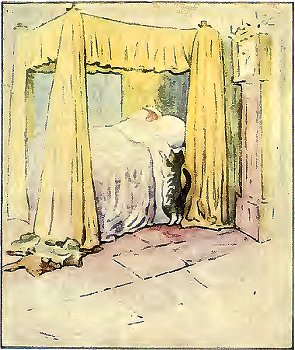
|

|
But that does not hinder the little brown mice; they run in and out
without any keys through all the old houses in Gloucester!
Out of doors the market folks went trudging through the snow to buy their
geese and turkeys, and to bake their Christmas pies; but there would be no
Christmas dinner for Simpkin and the poor old Tailor of Gloucester.
The tailor lay ill for three days and nights; and then it was Christmas
Eve, and very late at night. The moon climbed up over the roofs and
chimneys, and looked down over the gateway into College Court. There were
no lights in the windows, nor any sound in the houses; all the city of
Gloucester was fast asleep under the snow.
And still Simpkin wanted his mice, and he mewed as he stood beside the
four-post bed.
|
|
But it is in the old story that all the beasts can talk, in the night
between Christmas Eve and Christmas Day in the morning (though there are
very few folk that can hear them, or know what it is that they say).
When the Cathedral clock struck twelve there was an answer - like an echo
of the chimes - and Simpkin heard it, and came out of the tailor's door,
and wandered about in the snow.
From all the roofs and gables and old wooden houses in Gloucester came a
thousand merry voices singing the old Christmas rhymes - all the old songs
that ever I heard of, and some that I don't know, like Whittington's
bells. |

|

|
First and loudest the cocks cried out: "Dame, get up, and bake your pies!"
"Oh, dilly, dilly, dilly!" sighed Simpkin.
And now in a garret there were lights and sounds of dancing, and cats came
from over the way.
"Hey, diddle, diddle, the cat and the fiddle! All the cats in
Gloucester - except me," said Simpkin.
Under the wooden eaves the starlings and sparrows sang of Christmas pies;
the jack-daws woke up in the Cathedral tower; and although it was the
middle of the night the throstles and robins sang; the air was quite full
of little twittering tunes.
But it was all rather provoking to poor hungry Simpkin!
|
|
Particularly he was vexed with some little shrill voices from behind a
wooden lattice. I think that they were bats, because they always have very
small voices - especially in a black frost, when they talk in their sleep,
like the Tailor of Gloucester.
They said something mysterious that sounded like -
"Buz, quoth the blue fly, hum, quoth the bee,
Buz and hum they cry, and so do we!"
and Simpkin went away shaking his ears as if he had a bee in his bonnet.
From the tailor's shop in Westgate came a glow of light; and when Simpkin
crept up to peep in at the window it was full of candles. There was a
snippeting of scissors, and snappeting of thread; and little mouse voices
sang loudly and gaily -
|

|

|
"Four-and-twenty tailors
Went to catch a snail,
The best man amongst them
Durst not touch her tail,
She put out her horns
Like a little kyloe cow,
Run, tailors, run! or she'll have you all e'en now!"
Then without a pause the little mouse voices went on again -
"Sieve my lady's oatmeal,
Grind my lady's flour,
Put it in a chestnut,
Let it stand an hour - - "
|
|
"Mew! Mew!" interrupted Simpkin, and he scratched at the door. But the
key was under the tailor's pillow, he could not get in.
The little mice only laughed, and tried another tune -
"Three little mice sat down to spin,
Pussy passed by and she peeped in.
What are you at, my fine little men?
Making coats for gentlemen.
Shall I come in and cut off your threads?
Oh, no, Miss Pussy, you'd bite off our heads!"
|

|
 |
"Mew! Mew!" cried Simpkin. "Hey diddle dinketty?" answered the little
mice -
"Hey diddle dinketty, poppetty pet!
The merchants of London they wear scarlet;
Silk in the collar, and gold in the hem,
So merrily march the merchantmen!"
They clicked their thimbles to mark the time, but none of the songs
pleased Simpkin; he sniffed and mewed at the door of the shop.
|
"And then I bought
A pipkin and a popkin,
A slipkin and a slopkin,
All for one farthing - -
and upon the kitchen dresser!" added the rude little mice.
"Mew! scratch! scratch!" scuffled Simpkin on the window-sill; while the
little mice inside sprang to their feet, and all began to shout at once in
little twittering voices: "No more twist! No more twist!" And they barred
up the window shutters and shut out Simpkin.
But still through the nicks in the shutters he could hear the click of
thimbles, and little mouse voices singing -
|

|
"No more twist! No more twist!"

|
Simpkin came away from the shop and went home, considering in his mind. He
found the poor old tailor without fever, sleeping peacefully.
Then Simpkin went on tip-toe and took a little parcel of silk out of the
tea-pot, and looked at it in the moonlight; and he felt quite ashamed of
his badness compared with those good little mice!
When the tailor awoke in the morning, the first thing which he saw upon
the patchwork quilt, was a skein of cherry-coloured twisted silk, and
beside his bed stood the repentant Simpkin!
"Alack, I am worn to a ravelling," said the Tailor of Gloucester, "but I
have my twist!"
|
|
The sun was shining on the snow when the tailor got up and dressed, and
came out into the street with Simpkin running before him.
The starlings whistled on the chimney stacks, and the throstles and robins
sang - but they sang their own little noises, not the words they had sung
in the night.
"Alack," said the tailor, "I have my twist; but no more strength - nor
time - than will serve to make me one single button-hole; for this is
Christmas Day in the Morning! The Mayor of Gloucester shall be married by
noon - and where is his cherry-coloured coat?"
He unlocked the door of the little shop in Westgate Street, and Simpkin
ran in, like a cat that expects something.
|

|
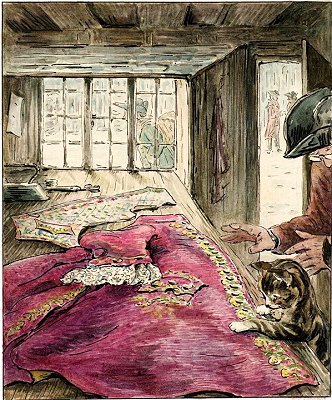 |
But there was no one there! Not even one little brown mouse!
The boards were swept clean; the little ends of thread and the little silk
snippets were all tidied away, and gone from off the floor.
But upon the table - oh joy! the tailor gave a shout - there, where he had
left plain cuttings of silk - there lay the most beautifullest coat and
embroidered satin waistcoat that ever were worn by a Mayor of Gloucester. |
|
There were roses and pansies upon the facings of the coat; and the
waistcoat was worked with poppies and corn-flowers.
Everything was finished except just one single cherry-coloured
button-hole, and where that button-hole was wanting there was pinned a
scrap of paper with these words - in little teeny weeny writing -
NO MORE TWIST
|
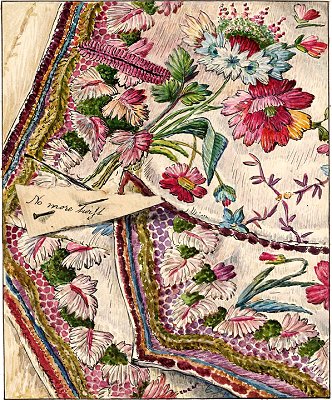
|
 |
And from then began the luck of the Tailor of Gloucester; he grew quite
stout, and he grew quite rich.
He made the most wonderful waistcoats for all the rich merchants of
Gloucester, and for all the fine gentlemen of the country round.
Never were seen such ruffles, or such embroidered cuffs and lappets! But
his button-holes were the greatest triumph of it all.
The stitches of those button-holes were so neat - so neat - I wonder how
they could be stitched by an old man in spectacles, with crooked old
fingers, and a tailor's thimble.
The stitches of those button-holes were so small - so small - they looked
as if they had been made by little mice!
|
THE END
Other Resources
We can't publish this page without reminding you about a great biographical movie staring Ren?e Zellweger as Miss Potter . The movie is family-friendly, and has some cutesey parts, but also portrays Beatrix Potter's struggles to make substantive choices in a society where women were expected to "know their place." . The movie is family-friendly, and has some cutesey parts, but also portrays Beatrix Potter's struggles to make substantive choices in a society where women were expected to "know their place."
In addition, if you want to purchase a version with the best example of the best print graphics, be sure to purchase the Penguin version. Penguin now owns Warne, Potter's original publisher, and has access to the original plates. Non-Penguin versions of this book use copies of the original Warne pages, and the result is often literally a pale imitation. By the way, if you want children to be able to read Bea Potter stories by themselves, individual books are better than the compilations, which are often very heavy and have pictures that are faded and reduced in size. version. Penguin now owns Warne, Potter's original publisher, and has access to the original plates. Non-Penguin versions of this book use copies of the original Warne pages, and the result is often literally a pale imitation. By the way, if you want children to be able to read Bea Potter stories by themselves, individual books are better than the compilations, which are often very heavy and have pictures that are faded and reduced in size.
If you would like to have a compilation, try to get the most recent Warne version.
This link was set up to link to that version the last time it was printed. The nice things about this one are that Warne has access to the original plates and has included "The Rabbits' Christmas Party," and other stories that have been left out of all "complete" collections so far. The big caveat is that this book is out of print, and since the 1980s, companies that have no access to the original art have published dozens of books called The Complete Works of Beatrix Potter or The Complete Peter Rabbit Collection, etc. So if you go to Amazon to buy the Warne Collection was set up to link to that version the last time it was printed. The nice things about this one are that Warne has access to the original plates and has included "The Rabbits' Christmas Party," and other stories that have been left out of all "complete" collections so far. The big caveat is that this book is out of print, and since the 1980s, companies that have no access to the original art have published dozens of books called The Complete Works of Beatrix Potter or The Complete Peter Rabbit Collection, etc. So if you go to Amazon to buy the Warne Collection , you have no way of guaranteeing that you'll get this version. So don't wait until the week before Christmas or a birthday to order, because, if they send the wrong one, you won't have time to lodge a complaint, send it back, and get the right one. , you have no way of guaranteeing that you'll get this version. So don't wait until the week before Christmas or a birthday to order, because, if they send the wrong one, you won't have time to lodge a complaint, send it back, and get the right one.
We have a big "complete" volume ourselves (one of the older ones without Warne's recent additions) and we enjoyed reading out of it to our children. This is a great way to make certain you don't overlook some of the lesser-known stories. Some folks have complained that they're too heavy for little kids to hold - a valid complaint if you don't understand the concept of you holding the book and reading it to your children. Others have complained because the cute little characters are occasionally put into dangerous situations. If you're squeamish about, say, Simpkin catching mice under tea-cups so he can snack on them later, you'll really dislike "Roly Poly Pudding." In that story - spoiler alert- a rat rolls Tom Kitten up in bread dough with the intention of baking him. (Tom gets away, of course.) Compared to Grimm or Andersen stories in which children get eaten or get their feet cut off or die of hunger, this is pretty tame stuff. But a number of modern parents seem to think all children's literature should be about as threatening as an episode of Teletubbies, and they don't mind whining when Potter's kittens and bunnies find themselves in danger. If you're one of those parents, be sure to keep this book out of reach of children and only ration out the stories as you think your children are ready for them. But, to be consistent, you'll also need to home-school, keep your kids away from all other children, books, and media, and unplug the television until they're about thirty.
Seriously, I think every home with children should have a good Beatrix Potter compilation, and as many of the individual books as there is room for on the nursery bookshelf. And every child should have these read to them until they're old enough to read them for themselves. Never mind the big words and occasional odd syntax - your kids' vocabulary and comprehension will improve by leaps and bounds if you read them books that are a tad "over their head." (My kids still remember me reading them the entire Chronicles of Narnia and The Hobbit when the youngest was far too young to read, and all three have exceptional reading skills and vocabularies.)
Not to mention that the works of Bea Potter are still superior to the vast majority of so-called "children's books" available today. Twenty years from now, 98% of the books that are currently on the "Children's" shelves in any bookstore will be forgotten and long since out of print. But Peter Rabbit, Tom Kitten, Benjamin Bunny, Jemima Puddleduck, Miss Tiggywinkle, and even Pipkin will still be around to charm future generations.
 If you've been reading our pages, you know that we have more planned. So keep checking back. And contact
us with any questions or suggestions you have in the meantime. If you've been reading our pages, you know that we have more planned. So keep checking back. And contact
us with any questions or suggestions you have in the meantime.
Paul and Shelia Race
www.familychristmasonline.com
To return to the Other Christmas Stories Page, click here.
To return to the Family Christmas Online? Home Page, click here.

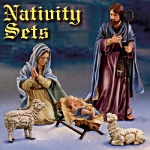

|

Visit any of the links below to see quality collectible Christmas gifts and
decorations that have been popular with our readers.
Note: Family Christmas Online? is a trademark of Breakthrough Communications(tm) (www.btcomm.com).
All information, data, text, and illustrations on this web site are
Copyright (c) 2006, 2007, 2008, 2009, 2010, 2011, 2012, 2013 by Paul D. Race.
Reuse or republication without prior written permission is specifically
forbidden.
Family Christmas Online(tm) is a participant in the Amazon Services LLC Associates Program, an affiliate advertising program designed to provide a means for sites to earn advertising fees by advertising and linking to amazon.com.
For more information, please contact
us
| Other Christmas resources and affiliated sites: |
|
| - Christmas Memories and Collectibles - |
|
 |

|

|

|

|

|
| - Family Activities and Crafts - |
|
 |

|

|

|

|

|
| - Trains and Hobbies - |
|

|

|

|  |

|

|
| - Music - |
|

|

|
 |

|

|

|
|



































